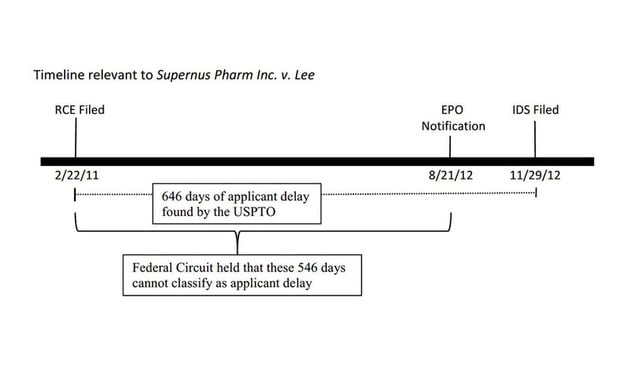Maximizing the Patent Term: USPTO Releases New Guidelines in View of 'Supernus'
Patent practitioners, especially those in the pharmaceutical industry, should be mindful of taking any action that might result in applicant delay, especially in the context of supplemental replies and information disclosure statements.
September 12, 2019 at 02:00 PM
8 minute read
 Credit: shutterstock
Credit: shutterstock
The United States Patent and Trademark Office (USPTO) published a notice in the Federal Register on May 9, 2019, informing patentees of the procedure to challenge Patent Term Adjustment (PTA) calculations in view of Supernus Pharm. v. Iancu, 913 F.3d. 1351 (Fed. Cir. 2019).
Patent Term Adjustment (PTA)
The PTA statute, 35 U.S.C. §154, provides for PTA in which a patent term may be extended beyond the standard 20-year term if the USPTO fails to act on a patent application in a timely manner. To arrive at the final PTA, the USPTO calculates the number of days it delayed the proceedings and reduces this number by the number of days that the patent applicant "failed to engage in reasonable efforts to conclude prosecution of the application." 35 U.S.C. §154(b)(2)(C)(i). This framework discourages both the USPTO and applicants from delaying the patent application process.
The USPTO prescribed regulations detailing how to calculate PTA in 37 C.F.R. §§1.702-1.704, including how applicant delay is calculated. The regulation at issue in Supernus was 37 C.F.R. §1.704(c)(8), which concerns situations in which the applicant files a supplemental reply. This section states that the following constitutes a failure of applicant to engage in reasonable efforts to conclude prosecution of the application:
Submission of a supplemental reply or other paper, other than a supplemental reply or other paper expressly requested by the examiner, after a reply has been filed, in which case the period of [patent term adjustment] shall be reduced by the number of days, if any, beginning on the day after the date the initial reply was filed and ending on the date that the supplemental reply or other such paper was filed.
The USPTO promulgated this regulation under 35 U.S.C. §154(b)(3)(A), which states that the USPTO "shall prescribe regulations establishing the circumstances that constitute a failure of an applicant to engage in reasonable efforts to conclude processing or examination of an application."
'Supernus Pharm. v. Iancu'
Supernus Pharmaceuticals owns U.S. Patent No. 8,747,897 (the '897 patent), which the USPTO issued with 1,260 days of PTA calculated from 2,146 days of USPTO delay and 886 days of applicant delay. Of the 866 days of this purported applicant delay, 646 days were from Feb. 22, 2011, the day Supernus filed a Request for Continued Examination (RCE), to Nov. 29, 2012, the day Supernus filed a Supplemental Information Disclosure Statement (IDS). The IDS disclosed a European Patent Office (EPO) Notification, Notice of Opposition, and the documents cited in the Notice of Opposition. Supernus filed this IDS 100 days after the EPO issued the notification. The USPTO considered the IDS to be a supplemental reply and classified the entire period beginning on the filing date of the RCE to the filing date of the IDS, a total of 646 days, as applicant delay in accordance with 37 C.F.R. §1.704(c)(8).

Supernus then challenged the USPTO's determination of 646 days of purported applicant delay associated with the IDS filing by filing a request for reconsideration. Specifically, Supernus argued that at least 546 days were not applicant delay because there was no applicant delay from the time the RCE was filed until at least the time the EPO issued the notification. The USPTO rejected the request for reconsideration. Supernus next appealed the USPTO's PTA determination on the grounds that 37 C.F.R. §1.704(c)(8) is arbitrary, capricious, and contrary to the PTA statute. The district court found in favor of the USPTO. Supernus Pharm. v. Lee, No. 1:16-CV-00342, 2016 WL 8739331 (E.D. Va. Oct. 18, 2016). However, on appeal, the Federal Circuit found in favor of Supernus and reversed the district court.
Importantly, the Federal Circuit found that the USPTO cannot "count as applicant delay any period of time during which there were no efforts in which the applicant could have engaged to conclude prosecution of the patent." 913 F.3d at 1359. The Federal Circuit then found that Supernus, the applicant in this case, could not have taken any efforts in the period of time from the filing of the RCE until the date of the EPO Notification of the Opposition. 913 F.3d at 1360. Thus, the Federal Circuit held that the USPTO's interpretation of the PTA statute was in excess of statutory authority in this case because the PTA statute states the amount of days of USPTO delay "shall be reduced by a period equal to the period of time during which the applicant failed to engage in reasonable efforts to conclude prosecution of the application." 35 U.S.C. §154(b)(2)(C)(i). The Federal Circuit reasoned that, since Supernus did not "fail to engage in reasonable efforts to conclude prosecution" for at least 546 days, the USPTO's interpretation of the PTA statute applied in these circumstances was inconsistent with the statute itself, and thus, the USPTO's interpretation is not subject to any deference. 913 F.3d at 1360.
The Federal Circuit distinguished the facts of Supernus from the fact pattern of Gilead Sciences v. Lee, 778 F.3d 1341 (Fed. Cir. 2015), a case in which the USPTO found applicant delay based on the same regulation, 37 C.F.R. §1.704(c)(8). In Gilead, the patent applicant first filed a response to a restriction requirement and then filed an IDS 57 days later. The USPTO classified this 57 days as applicant delay, and the Federal Circuit upheld this classification in its Gilead decision. The Federal Circuit emphasized that the applicant in Gilead failed to engage in reasonable efforts to conclude prosecution, while the applicant in Supernus did not. 913 F.3d at 1357. In the Gilead decision, the Federal Circuit held that the USPTO regulations were consistent with the PTA statute because (1) the patent applicant could have submitted the information in the IDS 57 days earlier, thereby eliminating any risk of delay; and (2) the patent applicant's action had the potential to cause delay regardless of whether it did, in fact, cause delay. 913 F.3d at 1357. In comparison, the patent applicant in Supernus could not have submitted the EPO Notification and related documents within the time the patent applicant was charged with delay. 913 F.3d at 1357.
USPTO's Subsequent May 9 Regulation
In response to the Supernus decision, the USPTO published a notice in the Federal Register on May 9, 2019, that detailed the modifications to its patent term adjustment procedures in view of the Supernus decision. Importantly, the USPTO did not change implementing regulations 37 C.F.R. §§1.702-1.704. Instead, the USPTO placed the burden on the patent applicant to identify periods of time that the USPTO classifies as applicant delay in which the patent applicant could not have undertaken any identifiable effort to conclude prosecution. If the patent applicant identifies periods incorrectly classified as applicant delay, then the patent applicant may file a request for reconsideration of the PTA no later than seven months from the date the patent was granted. 37 C.F.R. §1.705. In the May 9, 2019, publication, the USPTO claims that it cannot correct such errors itself because the system it uses to calculate PTA, the Patent Application Locating and Monitoring (PALM) system, does not have access to all information needed to correctly determine applicant delay, such as the foreign patent office information of the type at issue in Supernus.
Practice Tips
The goal of a patent practitioner should be to minimize any applicant delay in order to maximize any potential PTA. Thus, when filing a supplemental reply, a patent practitioner should be aware of the PTA implication and whether the filing might cause the USPTO to incorrectly calculate PTA as it did in Supernus. If a patent practitioner is aware of any USPTO miscalculation of PTA caused by a supplemental reply, then the client must be informed of the opportunity to file a request for reconsideration to extend the patent term.
Ideally, a patent practitioner will disclose any relevant information first disclosed in, or cited by, a patent office within 30 days of receiving such information under the safe harbor of 37 C.F.R. 1.704(d). This will minimize the likelihood that a request for reconsideration will be needed in cases similar to Supernus and is good patent practice. Even though Supernus was found to be entitled to the extra 546 days of PTA, an additional 100 days of patent protection was available had Supernus disclosed the information cited by the EPO within 30 days and made the certifications needed under 37 C.F.R. 1.704(d).
Patent practitioners, especially those in the pharmaceutical industry and other industries in which the back end of the patent term is typically valuable, should be mindful of taking any action that might result in applicant delay, especially in the context of supplemental replies and information disclosure statements.
James T. Corcoran is an associate in the Intellectual Property Department of Gibbons P.C. in Newark.
This content has been archived. It is available through our partners, LexisNexis® and Bloomberg Law.
To view this content, please continue to their sites.
Not a Lexis Subscriber?
Subscribe Now
Not a Bloomberg Law Subscriber?
Subscribe Now
NOT FOR REPRINT
© 2025 ALM Global, LLC, All Rights Reserved. Request academic re-use from www.copyright.com. All other uses, submit a request to [email protected]. For more information visit Asset & Logo Licensing.
You Might Like
View All
Send Us Your New Partners for the NJ Law Journal's New Partners Yearbook
1 minute read
New Methods for Clients and Families to Have Their Estate and Legacy Planning Complete
5 minute read
Tensions Run High at Final Hearing Before Manhattan Congestion Pricing Takes Effect
4 minute readTrending Stories
- 1'It's Not Going to Be Pretty': PayPal, Capital One Face Novel Class Actions Over 'Poaching' Commissions Owed Influencers
- 211th Circuit Rejects Trump's Emergency Request as DOJ Prepares to Release Special Counsel's Final Report
- 3Supreme Court Takes Up Challenge to ACA Task Force
- 4'Tragedy of Unspeakable Proportions:' Could Edison, DWP, Face Lawsuits Over LA Wildfires?
- 5Meta Pulls Plug on DEI Programs
Who Got The Work
Michael G. Bongiorno, Andrew Scott Dulberg and Elizabeth E. Driscoll from Wilmer Cutler Pickering Hale and Dorr have stepped in to represent Symbotic Inc., an A.I.-enabled technology platform that focuses on increasing supply chain efficiency, and other defendants in a pending shareholder derivative lawsuit. The case, filed Oct. 2 in Massachusetts District Court by the Brown Law Firm on behalf of Stephen Austen, accuses certain officers and directors of misleading investors in regard to Symbotic's potential for margin growth by failing to disclose that the company was not equipped to timely deploy its systems or manage expenses through project delays. The case, assigned to U.S. District Judge Nathaniel M. Gorton, is 1:24-cv-12522, Austen v. Cohen et al.
Who Got The Work
Edmund Polubinski and Marie Killmond of Davis Polk & Wardwell have entered appearances for data platform software development company MongoDB and other defendants in a pending shareholder derivative lawsuit. The action, filed Oct. 7 in New York Southern District Court by the Brown Law Firm, accuses the company's directors and/or officers of falsely expressing confidence in the company’s restructuring of its sales incentive plan and downplaying the severity of decreases in its upfront commitments. The case is 1:24-cv-07594, Roy v. Ittycheria et al.
Who Got The Work
Amy O. Bruchs and Kurt F. Ellison of Michael Best & Friedrich have entered appearances for Epic Systems Corp. in a pending employment discrimination lawsuit. The suit was filed Sept. 7 in Wisconsin Western District Court by Levine Eisberner LLC and Siri & Glimstad on behalf of a project manager who claims that he was wrongfully terminated after applying for a religious exemption to the defendant's COVID-19 vaccine mandate. The case, assigned to U.S. Magistrate Judge Anita Marie Boor, is 3:24-cv-00630, Secker, Nathan v. Epic Systems Corporation.
Who Got The Work
David X. Sullivan, Thomas J. Finn and Gregory A. Hall from McCarter & English have entered appearances for Sunrun Installation Services in a pending civil rights lawsuit. The complaint was filed Sept. 4 in Connecticut District Court by attorney Robert M. Berke on behalf of former employee George Edward Steins, who was arrested and charged with employing an unregistered home improvement salesperson. The complaint alleges that had Sunrun informed the Connecticut Department of Consumer Protection that the plaintiff's employment had ended in 2017 and that he no longer held Sunrun's home improvement contractor license, he would not have been hit with charges, which were dismissed in May 2024. The case, assigned to U.S. District Judge Jeffrey A. Meyer, is 3:24-cv-01423, Steins v. Sunrun, Inc. et al.
Who Got The Work
Greenberg Traurig shareholder Joshua L. Raskin has entered an appearance for boohoo.com UK Ltd. in a pending patent infringement lawsuit. The suit, filed Sept. 3 in Texas Eastern District Court by Rozier Hardt McDonough on behalf of Alto Dynamics, asserts five patents related to an online shopping platform. The case, assigned to U.S. District Judge Rodney Gilstrap, is 2:24-cv-00719, Alto Dynamics, LLC v. boohoo.com UK Limited.
Featured Firms
Law Offices of Gary Martin Hays & Associates, P.C.
(470) 294-1674
Law Offices of Mark E. Salomone
(857) 444-6468
Smith & Hassler
(713) 739-1250







